Phytotoxicity Assessment of Solanum lycopersicum L. Seedlings Moderately Irrigated with Non-Thermal Plasma Treated Water Containing Sulfamethoxazole
Abstract
1. Introduction
2. Materials and Methods
2.1. Characterization of the Irrigation Solutions
2.2. Experimental Set-Up
2.2.1. Petri Dishes Assay and Evaluated Endpoints
2.2.2. Pot Assay and Measured Biomarkers from Plants
2.2.3. Description of the Selected Soil and Measured Variables
2.3. Statistical Analysis
3. Results
3.1. Seed Germination, Vigor Indexes, and Seedling Morphometry
3.2. Plant Morpho-Physiological and Oxidative Non-Enzymatic Stress Responses
3.3. Soil Irrigation, Physical–Chemical, and Geochemical Characterization
3.4. Leaf Surface Microarchitecture and Element Spectra
4. Discussion
5. Conclusions
Author Contributions
Funding
Data Availability Statement
Acknowledgments
Conflicts of Interest
References
- Bártíková, H.; Podlipná, R.; Skálová, L. Veterinary Drugs in the Environment and Their Toxicity to Plants. Chemosphere 2016, 144, 2290–2301. [Google Scholar] [CrossRef] [PubMed]
- Ben Mordechay, E.; Mordehay, V.; Tarchitzky, J.; Chefetz, B. Pharmaceuticals in Edible Crops Irrigated with Reclaimed Wastewater: Evidence from a Large Survey in Israel. J. Hazard. Mater. 2021, 416, 126184. [Google Scholar] [CrossRef]
- Abdallat, G.A.; Salameh, E.; Shteiwi, M.; Bardaweel, S. Pharmaceuticals as Emerging Pollutants in the Reclaimed Wastewater Used in Irrigation and Their Effects on Plants, Soils, and Groundwater. Water 2022, 14, 1560. [Google Scholar] [CrossRef]
- Duan, W.; Cui, H.; Jia, X.; Huang, X. Occurrence and Ecotoxicity of Sulfonamides in the Aquatic Environment: A Review. Sci. Total Environ. 2022, 820, 153178. [Google Scholar] [CrossRef]
- Grenni, P.; Patrolecco, L.; Rauseo, J.; Spataro, F.; Di Lenola, M.; Aimola, G.; Zacchini, M.; Pietrini, F.; Di Baccio, D.; Stanton, I.C.; et al. Sulfamethoxazole Persistence in a River Water Ecosystem and Its Effects on the Natural Microbial Community and Lemna Minor Plant. Microchem. J. 2019, 149, 103999. [Google Scholar] [CrossRef]
- Duarte, J.A.P.; Ribeiro, A.K.N.; de Carvalho, P.; Bortolini, J.C.; Ostroski, I.C. Emerging Contaminants in the Aquatic Environment: Phytoplankton Structure in the Presence of Sulfamethoxazole and Diclofenac. Environ. Sci. Pollut. Res. 2023, 30, 46604–46617. [Google Scholar] [CrossRef]
- Camacho-Arévalo, R.; García-Delgado, C.; Mayans, B.; Antón-Herrero, R.; Cuevas, J.; Segura, M.L.; Eymar, E. Sulfonamides in Tomato from Commercial Greenhouses Irrigated with Reclaimed Wastewater: Uptake, Translocation and Food Safety. Agronomy 2021, 11, 1016. [Google Scholar] [CrossRef]
- Anh, H.Q.; Le, T.P.Q.; Da Le, N.; Lu, X.X.; Duong, T.T.; Garnier, J.; Rochelle-Newall, E.; Zhang, S.; Oh, N.H.; Oeurng, C.; et al. Antibiotics in Surface Water of East and Southeast Asian Countries: A Focused Review on Contamination Status, Pollution Sources, Potential Risks, and Future Perspectives. Sci. Total Environ. 2021, 764, 142865. [Google Scholar] [CrossRef]
- Kim, Y.; Choi, K.; Jung, J.; Park, S.; Kim, P.G.; Park, J. Aquatic Toxicity of Acetaminophen, Carbamazepine, Cimetidine, Diltiazem and Six Major Sulfonamides, and Their Potential Ecological Risks in Korea. Environ. Int. 2007, 33, 370–375. [Google Scholar] [CrossRef]
- Cheng, S.; Shi, M.; Xing, L.; Wang, X.; Gao, H.; Sun, Y. Sulfamethoxazole Affects the Microbial Composition and Antibiotic Resistance Gene Abundance in Soil and Accumulates in Lettuce. Environ. Sci. Pollut. Res. 2020, 27, 29257–29265. [Google Scholar] [CrossRef]
- Ren, J.; Lu, H.; Lu, S.; Huang, Z. Impacts of Sulfamethoxazole Stress on Vegetable Growth and Rhizosphere Bacteria and the Corresponding Mitigation Mechanism. Front. Bioeng. Biotechnol. 2024, 12, 303670. [Google Scholar] [CrossRef] [PubMed]
- Bombaywala, S.; Mandpe, A.; Paliya, S.; Kumar, S. Antibiotic Resistance in the Environment: A Critical Insight on Its Occurrence, Fate, and Eco-Toxicity. Environ. Sci. Pollut. Res. 2021, 28, 24889–24916. [Google Scholar] [CrossRef] [PubMed]
- Wei, H.; Tang, M.; Xu, X. Mechanism of Uptake, Accumulation, Transport, Metabolism and Phytotoxic Effects of Pharmaceuticals and Personal Care Products within Plants: A Review. Sci. Total Environ. 2023, 892, 164413. [Google Scholar] [CrossRef]
- Wu, X.; Ernst, F.; Conkle, J.L.; Gan, J. Comparative Uptake and Translocation of Pharmaceutical and Personal Care Products (PPCPs) by Common Vegetables. Environ. Int. 2013, 60, 15–22. [Google Scholar] [CrossRef] [PubMed]
- Pino, M.R.; Muñiz, S.; Val, J.; Navarro, E. Phytotoxicity of 15 Common Pharmaceuticals on the Germination of Lactuca Sativa and Photosynthesis of Chlamydomonas Reinhardtii. Environ. Sci. Pollut. Res. 2016, 23, 22530–22541. [Google Scholar] [CrossRef]
- Miller, E.L.; Nason, S.L.; Karthikeyan, K.G.; Pedersen, J.A. Root Uptake of Pharmaceuticals and Personal Care Product Ingredients. Environ. Sci. Technol. 2016, 50, 525–541. [Google Scholar] [CrossRef]
- Menacherry, S.P.M.; Kodešová, R.; Švecová, H.; Klement, A.; Fér, M.; Nikodem, A.; Grabic, R. Selective Accumulation of Pharmaceutical Residues from 6 Different Soils by Plants: A Comparative Study on Onion, Radish, and Spinach. Environ. Sci. Pollut. Res. 2023, 30, 54160–54176. [Google Scholar] [CrossRef]
- Christou, A.; Kyriacou, M.C.; Georgiadou, E.C.; Papamarkou, R.; Hapeshi, E.; Karaolia, P.; Michael, C.; Fotopoulos, V.; Fatta-Kassinos, D. Uptake and Bioaccumulation of Three Widely Prescribed Pharmaceutically Active Compounds in Tomato Fruits and Mediated Effects on Fruit Quality Attributes. Sci. Total Environ. 2019, 647, 1169–1178. [Google Scholar] [CrossRef]
- Brain, R.A.; Ramirez, A.J.; Fulton, B.A.; Chambliss, C.K.; Brooks, B.W. Herbicidal Effects of Sulfamethoxazole in Lemna Gibba: Using p-Aminobenzoic Acid as a Biomarker of Effect. Environ. Sci. Technol. 2008, 42, 8965–8970. [Google Scholar] [CrossRef]
- Christou, A.; Karaolia, P.; Hapeshi, E.; Michael, C.; Fatta-Kassinos, D. Long-Term Wastewater Irrigation of Vegetables in Real Agricultural Systems: Concentration of Pharmaceuticals in Soil, Uptake and Bioaccumulation in Tomato Fruits and Human Health Risk Assessment. Water Res. 2017, 109, 24–34. [Google Scholar] [CrossRef]
- Arredondo, A.; Ramírez-Vargas, C.A.; Cubillos, J.A.; Arrubla, J.P.; Morales-Pinzon, T.; Paredes, D.; Arias, C.A. Toxicity and Removal of Pharmaceutical and Personal Care Products: A Laboratory Scale Study with Tropical Plants for Treatment Wetlands. Water Sci. Technol. 2022, 85, 2240–2253. [Google Scholar] [CrossRef] [PubMed]
- Ercoli, L.; Rossetto, R.; Di Giorgi, S.; Raffaelli, A.; Nuti, M.; Pellegrino, E. Effective Bioremediation of Clarithromycin and Diclofenac in Wastewater by Microbes and Arundo donax L. Environ. Sci. Pollut. Res. 2023, 30, 77193–77209. [Google Scholar] [CrossRef]
- Chen, H.R.; Rairat, T.; Loh, S.H.; Wu, Y.C.; Vickroy, T.W.; Chou, C.C. Assessment of Veterinary Drugs in Plants Using Pharmacokinetic Approaches: The Absorption, Distribution and Elimination of Tetracycline and Sulfamethoxazole in Ephemeral Vegetables. PLoS ONE 2017, 12, e0183087. [Google Scholar] [CrossRef] [PubMed]
- Dudley, S.; Sun, C.; Jiang, J.; Gan, J. Metabolism of Sulfamethoxazole in Arabidopsis Thaliana Cells and Cucumber Seedlings. Environ. Pollut. 2018, 242, 1748–1757. [Google Scholar] [CrossRef]
- Christou, A.; Antoniou, C.; Christodoulou, C.; Hapeshi, E.; Stavrou, I.; Michael, C.; Fatta-Kassinos, D.; Fotopoulos, V. Stress-Related Phenomena and Detoxification Mechanisms Induced by Common Pharmaceuticals in Alfalfa (Medicago sativa L.) Plants. Sci. Total Environ. 2016, 557–558, 652–664. [Google Scholar] [CrossRef] [PubMed]
- de Boer, M.A.; Hammerton, M.; Slootweg, J.C. Uptake of Pharmaceuticals by Sorbent-Amended Struvite Fertilisers Recovered from Human Urine and Their Bioaccumulation in Tomato Fruit. Water Res. 2018, 133, 19–26. [Google Scholar] [CrossRef]
- Lupo, A.; Coyne, S.; Berendonk, T.U. Origin and Evolution of Antibiotic Resistance: The Common Mechanisms of Emergence and Spread in Water Bodies. Front. Microbiol. 2012, 3, 18700. [Google Scholar] [CrossRef] [PubMed]
- Hu, S.; Yan, W.; Yu, J.; Zhu, B.; Lan, Y.; Xi, W.; Xu, Z.; Han, W.; Cheng, C. Degradation of Sulfamethoxazole in Water by Dielectric Barrier Discharge Plasma Jet: Influencing Parameters, Degradation Pathway, Toxicity Evaluation. Plasma Sci. Technol. 2023, 25, 035510. [Google Scholar] [CrossRef]
- Cyganowski, P.; Terefinko, D.; Motyka-Pomagruk, A.; Babinska-Wensierska, W.; Khan, M.A.; Klis, T.; Sledz, W.; Lojkowska, E.; Jamroz, P.; Pohl, P.; et al. The Potential of Cold Atmospheric Pressure Plasmas for the Direct Degradation of Organic Pollutants Derived from the Food Production Industry. Molecules 2024, 29, 2910. [Google Scholar] [CrossRef]
- Magureanu, M.; Bilea, F.; Bradu, C.; Hong, D. A Review on Non-Thermal Plasma Treatment of Water Contaminated with Antibiotics. J. Hazard. Mater. 2021, 417, 125481. [Google Scholar] [CrossRef]
- Sanito, R.C.; You, S.J.; Wang, Y.F. Degradation of Contaminants in Plasma Technology: An Overview. J. Hazard. Mater. 2022, 424, 127390. [Google Scholar] [CrossRef] [PubMed]
- Englande, A.J.; Krenkel, P.; Shamas, J. Wastewater Treatment & Water Reclamation. In Reference Module in Earth Systems and Environmental Sciences; Elsevier: Amsterdam, The Netherlands, 2015. [Google Scholar]
- Morin-Crini, N.; Lichtfouse, E.; Fourmentin, M.; Ribeiro, A.R.L.; Noutsopoulos, C.; Mapelli, F.; Fenyvesi, É.; Vieira, M.G.A.; Picos-Corrales, L.A.; Moreno-Piraján, J.C.; et al. Removal of Emerging Contaminants from Wastewater Using Advanced Treatments. A Review. Environ. Chem. Lett. 2022, 20, 1333–1375. [Google Scholar] [CrossRef]
- Bruggeman, P.J.; Kushner, M.J.; Locke, B.R.; Gardeniers, J.G.E.; Graham, W.G.; Graves, D.B.; Hofman-Caris, R.C.H.M.; Maric, D.; Reid, J.P.; Ceriani, E.; et al. Plasma-Liquid Interactions: A Review and Roadmap. Plasma Sources Sci. Technol. 2016, 25, 053002. [Google Scholar] [CrossRef]
- Bilea, F.; Bradu, C.; Cicirma, M.; Medvedovici, A.V.; Magureanu, M. Plasma Treatment of Sulfamethoxazole Contaminated Water: Intermediate Products, Toxicity Assessment and Potential Agricultural Reuse. Sci. Total Environ. 2024, 909, 168524. [Google Scholar] [CrossRef] [PubMed]
- Brault, P.; Bilea, F.; Magureanu, M.; Bradu, C.; Aubry, O.; Rabat, H.; Hong, D. Plasma Degradation of Water Organic Pollutants: Ab Initio Molecular Dynamics Simulations and Experiments. Plasma Process. Polym. 2023, 20, e2300116. [Google Scholar] [CrossRef]
- Kim, J.H.; Min, S.C. Microwave-Powered Cold Plasma Treatment for Improving Microbiological Safety of Cherry Tomato against Salmonella. Postharvest Biol. Technol. 2017, 127, 21–26. [Google Scholar] [CrossRef]
- Pérez-Pizá, M.C.; Prevosto, L.; Grijalba, P.E.; Zilli, C.G.; Cejas, E.; Mancinelli, B.; Balestrasse, K.B. Improvement of Growth and Yield of Soybean Plants through the Application of Non-Thermal Plasmas to Seeds with Different Health Status. Heliyon 2019, 5, e01495. [Google Scholar] [CrossRef]
- Ivankov, A.; Nauciene, Z.; Zukiene, R.; Degutyte-Fomins, L.; Malakauskiene, A.; Kraujalis, P.; Venskutonis, P.R.; Filatova, I.; Lyushkevich, V.; Mildaziene, V. Changes in Growth and Production of Non-Psychotropic Cannabinoids Induced by Pre-Sowing Treatment of Hemp Seeds with Cold Plasma, Vacuum and Electromagnetic Field. Appl. Sci. 2020, 10, 8519. [Google Scholar] [CrossRef]
- Sirgedaitė-Šėžienė, V.; Mildažienė, V.; Žemaitis, P.; Ivankov, A.; Koga, K.; Shiratani, M.; Baliuckas, V. Long-Term Response of Norway Spruce to Seed Treatment with Cold Plasma: Dependence of the Effects on the Genotype. Plasma Process. Polym. 2021, 18, 2000159. [Google Scholar] [CrossRef]
- Florescu, I.; Radu, I.; Teodoru, A.; Gurau, L.; Chireceanu, C.; Bilea, F.; Magureanu, M. Positive Effect Induced by Plasma Treatment of Seeds on the Agricultural Performance of Sunflower. Plants 2023, 12, 794. [Google Scholar] [CrossRef]
- Back, J.O.; Obholzer, T.; Winkler, K.; Jabornig, S.; Rupprich, M. Combining Ultrafiltration and Non-Thermal Plasma for Low Energy Degradation of Pharmaceuticals from Conventionally Treated Wastewater. J. Environ. Chem. Eng. 2018, 6, 7377–7385. [Google Scholar] [CrossRef]
- Kovalakova, P.; Cizmas, L.; McDonald, T.J.; Marsalek, B.; Feng, M.; Sharma, V.K. Occurrence and Toxicity of Antibiotics in the Aquatic Environment: A Review. Chemosphere 2020, 251, 126351. [Google Scholar] [CrossRef]
- Cheong, M.S.; Seo, K.H.; Chohra, H.; Yoon, Y.E.; Choe, H.; Kantharaj, V.; Lee, Y.B. Influence of Sulfonamide Contamination Derived from Veterinary Antibiotics on Plant Growth and Development. Antibiotics 2020, 9, 456. [Google Scholar] [CrossRef]
- Bilea, F.; Bradu, C.; Mandache, N.B.; Magureanu, M. Characterization of the Chemical Activity of a Pulsed Corona Discharge above Water. Chemosphere 2019, 236, 124302. [Google Scholar] [CrossRef]
- Bilea, F.; Bradu, C.; Magureanu, M. Potential of Plasma Treatment as Water Reclamation Process for Irrigation. J. Phys. D Appl. Phys. 2020, 53, 224002. [Google Scholar] [CrossRef]
- Domingues Neto, F.J.; Carneiro, D.C.d.S.; Putti, F.F.; Rodrigues, J.D.; Tecchio, M.A.; Leonel, S.; Silva, M.d.S. Physiological Indexes in Seed Germination and Seedling Growth of Rangpur Lime (Citrus limonia L. Osbeck) under Plant Growth Regulators. Agronomy 2024, 14, 2066. [Google Scholar] [CrossRef]
- Ivshina, I.B.; Tyumina, E.A.; Bazhutin, G.A.; Vikhareva, E.V. Response of Rhodococcus Cerastii IEGM 1278 to Toxic Effects of Ibuprofen. PLoS ONE 2021, 16, e0260032. [Google Scholar] [CrossRef]
- Synowiec, A.; Kalemba, D.; Drozdek, E.; Bocianowski, J. Phytotoxic Potential of Essential Oils from Temperate Climate Plants against the Germination of Selected Weeds and Crops. J. Pest Sci. 2017, 90, 407–419. [Google Scholar] [CrossRef]
- Neagoe, A.; Iordache, V.; Bergmann, H.; Kothe, E. Patterns of Effects of Arbuscular Mycorrhizal Fungi on Plants Grown in Contaminated Soil. J. Plant Nutr. Soil Sci. 2013, 176, 273–286. [Google Scholar] [CrossRef]
- von Alten, H.; Blal, B.; Dodd, J.C.; Feldmann, F.; Vosatka, M. Quality Control of Arbuscular Mycorrhizal Fungi Inoculum in Europe. In Mycorrhizal Technology in Agriculture; Springer: Berlin/Heidelberg, Germany, 2002. [Google Scholar]
- Fanourakis, D.; Giday, H.; Milla, R.; Pieruschka, R.; Kjaer, K.H.; Bolger, M.; Vasilevski, A.; Nunes-Nesi, A.; Fiorani, F.; Ottosen, C.O. Pore Size Regulates Operating Stomatal Conductance, While Stomatal Densities Drive the Partitioning of Conductance between Leaf Sides. Ann. Bot. 2015, 115, 555–565. [Google Scholar] [CrossRef] [PubMed]
- Kørup, K.; Lærke, P.E.; Baadsgaard, H.; Andersen, M.N.; Kristensen, K.; Münnich, C.; Didion, T.; Jensen, E.S.; Mårtensson, L.M.; Jørgensen, U. Biomass Production and Water Use Efficiency in Perennial Grasses during and after Drought Stress. GCB Bioenergy 2018, 10, 12–27. [Google Scholar] [CrossRef]
- Hodges, D.M.; DeLong, J.M.; Forney, C.F.; Prange, R.K. Improving the Thiobarbituric Acid-Reactive-Substances Assay for Estimating Lipid Peroxidation in Plant Tissues Containing Anthocyanin and Other Interfering Compounds. Planta 1999, 207, 604–611. [Google Scholar] [CrossRef]
- Schopfer, P. Experimentelle Pflanzenphysiologie—Einführung in Die Anwendungtle; Band 2; Springer: Berlin/Heidelberg, Germany, 1989. [Google Scholar]
- Schmitz, O.; Danneberg, G.; Hundeshagen, B.; Klingner, A.; Bothe, H. Quantification of Vesicular-Arbuscular Mycorrhiza by Biochemical Parameters. J. Plant Physiol. 1991, 139, 106–114. [Google Scholar] [CrossRef]
- Trouvelot, A.; Kough, J.L.; Gianinazzi-Pearson, V. Estimation Du Taux de Mycorhization d’un Système Radiculaire. In Mycorhizes: Physiologie et Génétique; INRA: Paris, France, 1986. [Google Scholar]
- Anger, I.; Volceanov, E.; Plopeanu, G.; Ilie, L.; Popescu, L.G.; Moise, G.A. Remediere a Solurilor Acide În Agricultură Impact of Metallurgical Ladle Furnace Slag on Acid Soil Remediation in Agriculture. Rom. J. Mater./Rev. Romana Mater. 2018, 48, 76–82. [Google Scholar]
- Bower, C.E.; Holm-Hansen, T. A Salicylate–Hypochlorite Method for Determining Ammonia in Seawater. Can. J. Fish. Aquat. Sci. 1980, 37, 794–798. [Google Scholar] [CrossRef]
- Qiu, X.C.; Liu, G.P.; Zhu, Y.Q. Determination of Water-Soluble Ammonium Ion in Soil by Spectrophotometry. Analyst 1987, 112, 909–911. [Google Scholar] [CrossRef]
- Keeney, D.R.; Nelson, D.W. Nitrogen—Inorganic Forms. In Methods of Soil Analysis: Part 2 Chemical and Microbiological Properties; American Society of Agronomy: Madison, WI, USA, 1982. [Google Scholar]
- Hess, H.H.; Derr, J.E. Assay of Inorganic and Organic Phosphorus in the 0.1–5 Nanomole Range. Anal. Biochem. 1975, 63, 607–613. [Google Scholar] [CrossRef]
- Anderson, J.M.; Ingram, J.S.I. Tropical Soil Biology and Fertility: A Handbook of Methods, 2nd ed.; CAB International: Egham, UK, 1993. [Google Scholar]
- Rowell, D.L. Soil Science: Methods & Applications; Routledge: Oxford, UK, 1994; ISBN 9781315844855. [Google Scholar]
- Neagoe, A.; Ebenå, G.; Carlsson, E. The effect of soil amendments on plant performance in an area affected by acid mine drainage. Geochemistry 2005, 65, 115–129. [Google Scholar] [CrossRef]
- Neagoe, A.; Iordache, V.A. Ghid de Remediere a Zonelor Poluate Cu Elemente Toxice; Universitatea din București: Bucharest, Romania, 2021. [Google Scholar] [CrossRef]
- INRA Référentiel Pédologique. In Association Française d’Étude des Sols; INRA: Paris, France, 1995; p. 332.
- Davidescu, D.V. Agrochimia Horticola; Ed. Academiei Române: Bucuresti, Romania, 1992. [Google Scholar]
- Arshad, M.A.; Martin, S. Identifying Critical Limits for Soil Quality Indicators in Agro-Ecosystems. Agric. Ecosyst. Environ. 2002, 88, 153–160. [Google Scholar] [CrossRef]
- Huang, P.-T.; Patel, M.; Santagata, M.C.; Bobet, A. FHWA/IN/JTRP-2008/2 Final—Final Report—Classification of Organic Soils; Joint Transportation Research Program Project No. C-36-36TT; File No. 6-14-45 SPR-3005; Purdue University: West Lafayette, IN, USA, 2009. [Google Scholar]
- Griffin, G.; Jokela, W.; Ross, D.; Pettinelli, D.; Morris, T.; Wolf, A. Recommended Soil Nitrate Tests. In Recommended Soil Testing Procedures for the Northeastern United States; Northeastern University Library: Boston, MA, USA, 2011. [Google Scholar]
- Howard, J.B.; Rees, D.C. How Many Metals Does It Take to Fix N2? A Mechanistic Overview of Biological Nitrogen Fixation. Proc. Natl. Acad. Sci. USA 2006, 103, 17088–17093. [Google Scholar] [CrossRef] [PubMed]
- Kabata-Pendias, A. Trace Elements in Soils and Plants, 4th ed.; CRC Press by Taylor and Francis Group: Boca Raton, FL, USA, 2010; ISBN 9781420093704. [Google Scholar]
- Mouhamad, R.; Alsaede, A.; Iqbal, M. Behavior of Potassium in Soil: A Mini Review. Chem. Int. 2016, 2, 58–69. [Google Scholar]
- Kabata-Pendias, A. Behavioural Properties of Trace Metals in Soils. Appl. Geochem. 1993, 8, 3–9. [Google Scholar] [CrossRef]
- Gambonnet, B.; Jabrin, S.; Ravanel, S.; Karan, M.; Douce, R.; Rébeillé, F. Folate Distribution during Higher Plant Development. J. Sci. Food Agric. 2001, 81, 835–841. [Google Scholar] [CrossRef]
- Gorelova, V.; Ambach, L.; Rébeillé, F.; Stove, C.; Van Der Straeten, D. Folates in Plants: Research Advances and Progress in Crop Biofortification. Front. Chem. 2017, 5, 21. [Google Scholar] [CrossRef]
- Mukhtar, A.; Manzoor, M.; Gul, I.; Zafar, R.; Jamil, H.I.; Niazi, A.K.; Ali, M.A.; Park, T.J.; Arshad, M. Phytotoxicity of Different Antibiotics to Rice and Stress Alleviation upon Application of Organic Amendments. Chemosphere 2020, 258, 127353. [Google Scholar] [CrossRef]
- Jin, C.; Chen, Q.; Sun, R.; Zhou, Q.; Liu, J. Eco-Toxic Effects of Sulfadiazine Sodium, Sulfamonomethoxine Sodium and Enrofloxacin on Wheat, Chinese Cabbage and Tomato. Ecotoxicology 2009, 18, 878–885. [Google Scholar] [CrossRef]
- Carballo, M.; Rodríguez, A.; de la Torre, A. Phytotoxic Effects of Antibiotics on Terrestrial Crop Plants and Wild Plants: A Systematic Review. Arch. Environ. Contam. Toxicol. 2022, 82, 48–61. [Google Scholar] [CrossRef]
- Li, L.; Li, T.; Liu, Y.; Li, L.; Huang, X.; Xie, J. Effects of Antibiotics Stress on Root Development, Seedling Growth, Antioxidant Status and Abscisic Acid Level in Wheat (Triticum aestivum L.). Ecotoxicol. Environ. Saf. 2023, 252, 114621. [Google Scholar] [CrossRef]
- Thirumdas, R.; Kothakota, A.; Annapure, U.; Siliveru, K.; Blundell, R.; Gatt, R.; Valdramidis, V.P. Plasma Activated Water (PAW): Chemistry, Physico-Chemical Properties, Applications in Food and Agriculture. Trends Food Sci. Technol. 2018, 77, 21–31. [Google Scholar] [CrossRef]
- Dobrin, D.; Magureanu, M.; Mandache, N.B.; Ionita, M.D. The Effect of Non-Thermal Plasma Treatment on Wheat Germination and Early Growth. Innov. Food Sci. Emerg. Technol. 2015, 29, 255–260. [Google Scholar] [CrossRef]
- Sivachandiran, L.; Khacef, A. Enhanced Seed Germination and Plant Growth by Atmospheric Pressure Cold Air Plasma: Combined Effect of Seed and Water Treatment. RSC Adv. 2017, 7, 1822–1832. [Google Scholar] [CrossRef]
- Šerá, B.; Scholtz, V.; Jirešová, J.; Khun, J.; Julák, J.; Šerý, M. Effects of Non-Thermal Plasma Treatment on Seed Germination and Early Growth of Leguminous Plants—A Review. Plants 2021, 10, 1616. [Google Scholar] [CrossRef]
- Marschner, H. Marschner’s Mineral Nutrition of Higher Plants, 3rd ed.; Academic Press: Cambridge, MA, USA, 1996; ISBN 9780123849052. [Google Scholar]
- Zhang, Y.; He, D.; Chang, F.; Dang, C.; Fu, J. Combined Effects of Sulfamethoxazole and Erythromycin on a Freshwater Microalga, Raphidocelis Subcapitata: Toxicity and Oxidative Stress. Antibiotics 2021, 10, 576. [Google Scholar] [CrossRef]
- Ahmad, R.; Muhammad, H.M.D.; Naz, S.; Manzoor, M.; Altaf, M.A. Biochemical Mechanism Unlocking Their Potential Role in Salt Tolerance Mechanism of Zizyphus Germplasm. Phyton-Int. J. Exp. Bot. 2023, 92, 1539–1553. [Google Scholar] [CrossRef]
- Opriş, O.; Ciorîţă, A.; Soran, M.L.; Lung, I.; Copolovici, D.; Copolovici, L. Evaluation of the Photosynthetic Parameters, Emission of Volatile Organic Compounds and Ultrastructure of Common Green Leafy Vegetables after Exposure to Non-Steroidal Anti-Inflammatory Drugs (NSAIDs). Ecotoxicology 2019, 28, 631–642. [Google Scholar] [CrossRef]
- Copaciu, F.; Opriş, O.; Niinemets, Ü.; Copolovici, L. Toxic Influence of Key Organic Soil Pollutants on the Total Flavonoid Content in Wheat Leaves. Water Air Soil Pollut. 2016, 227, 196. [Google Scholar] [CrossRef]
- Opriș, O.; Lung, I.; Soran, M.L.; Ciorîță, A.; Copolovici, L. Investigating the Effects of Non-Steroidal Anti-Inflammatory Drugs (NSAIDs) on the Composition and Ultrastructure of Green Leafy Vegetables with Important Nutritional Values. Plant Physiol. Biochem. 2020, 151, 342–351. [Google Scholar] [CrossRef]
- Leti, L.I.; Gerber, I.C.; Mihaila, I.; Galan, P.M.; Strajeru, S.; Petrescu, D.E.; Cimpeanu, M.M.; Topala, I.; Gorgan, D.L. The Modulatory Effects of Non-Thermal Plasma on Seed’s Morphology, Germination and Genetics—A Review. Plants 2022, 11, 2181. [Google Scholar] [CrossRef]
- Luu, D.T.; Maurel, C. Aquaporins in a Challenging Environment: Molecular Gears for Adjusting Plant Water Status. Plant Cell Environ. 2005, 28, 85–96. [Google Scholar] [CrossRef]
- Mildaziene, V.; Sera, B. Effects of Non-Thermal Plasma Treatment on Plant Physiological and Biochemical Processes. Plants 2022, 11, 1018. [Google Scholar] [CrossRef]



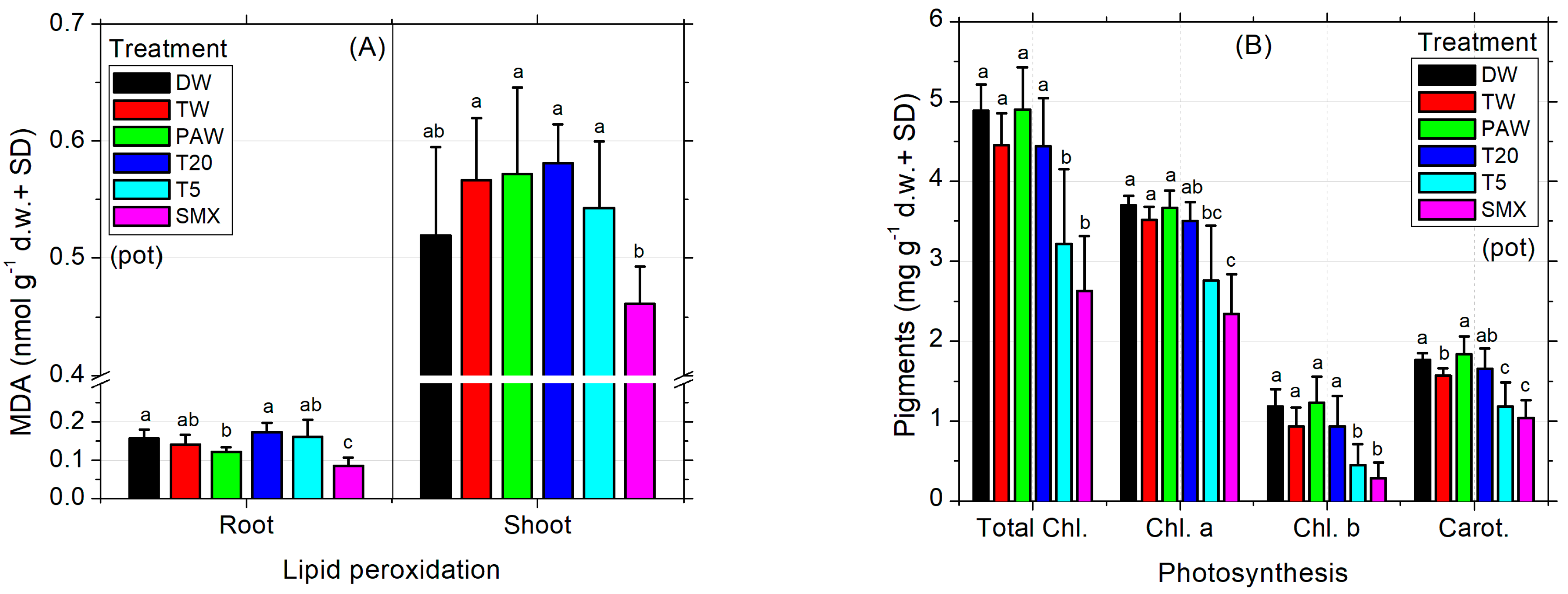

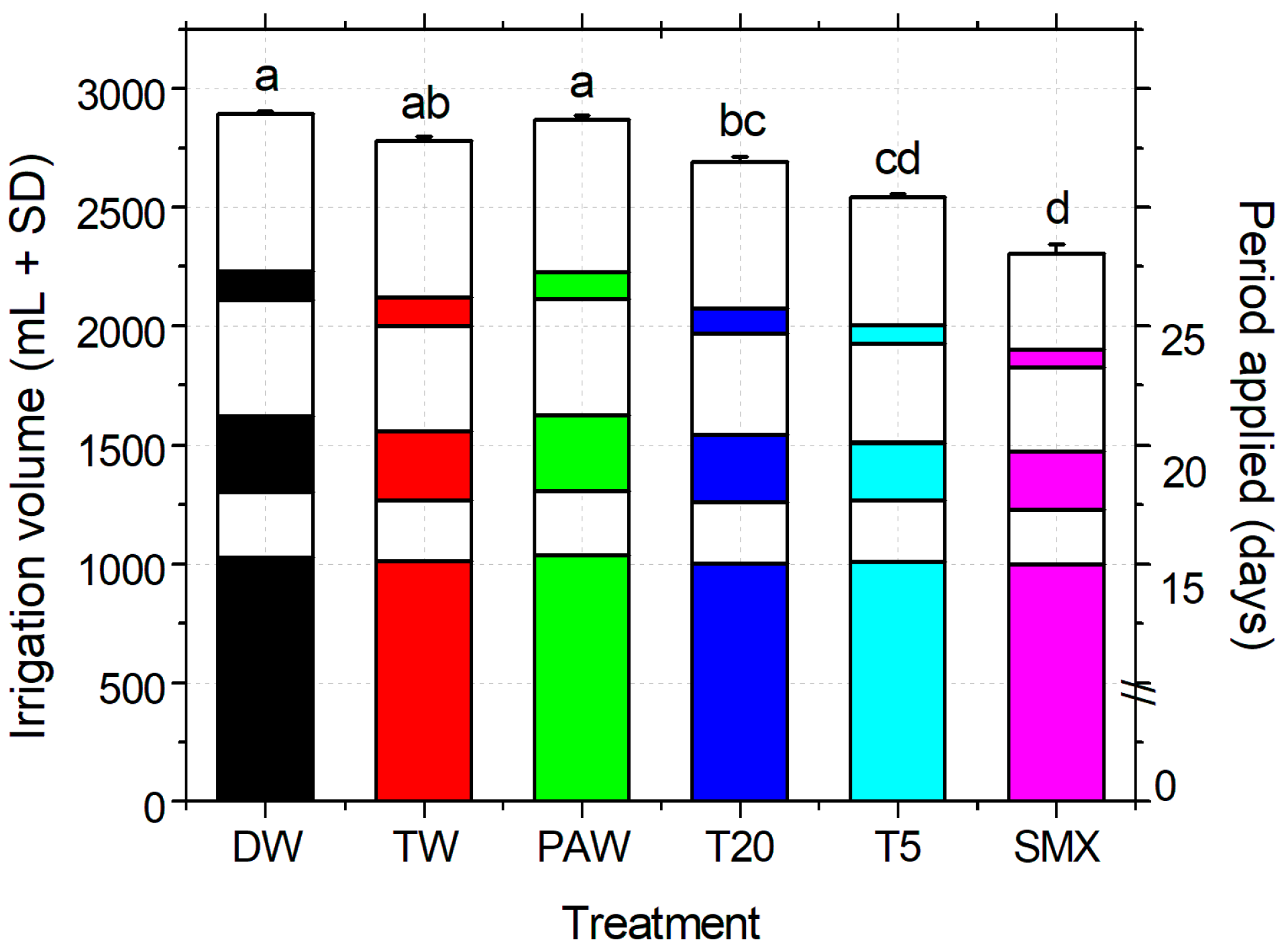
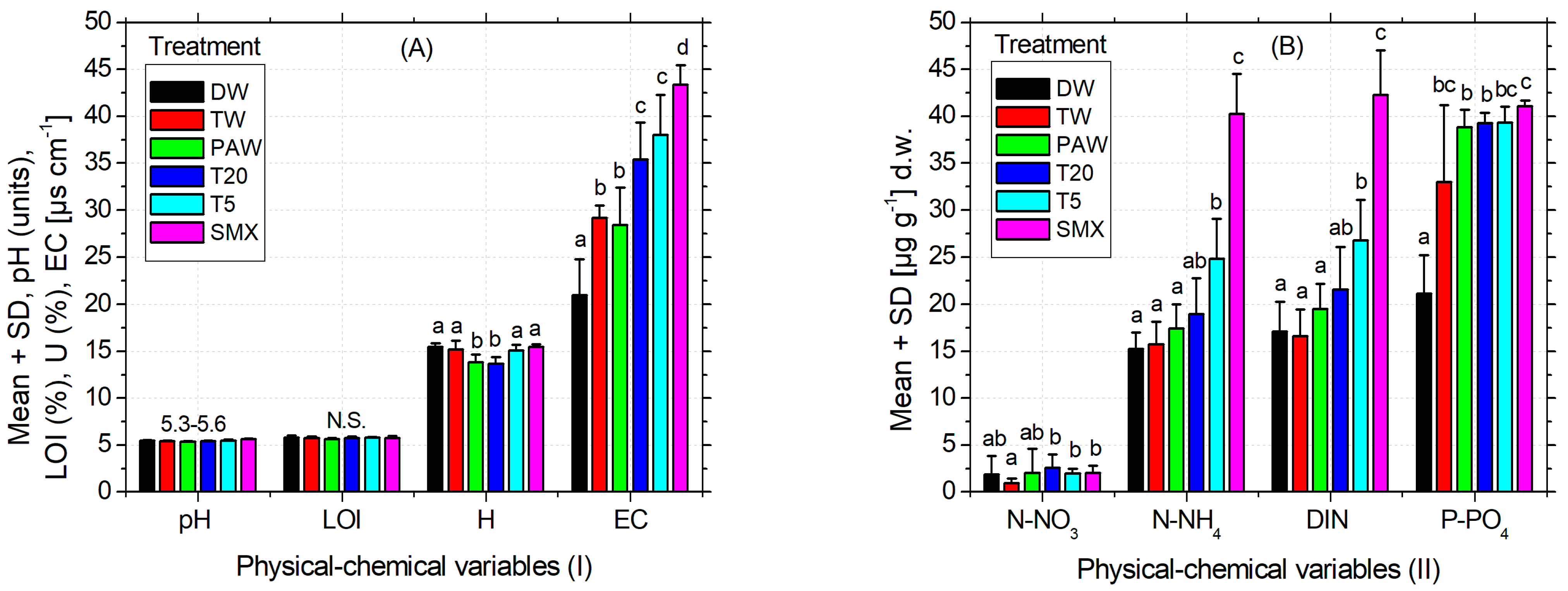
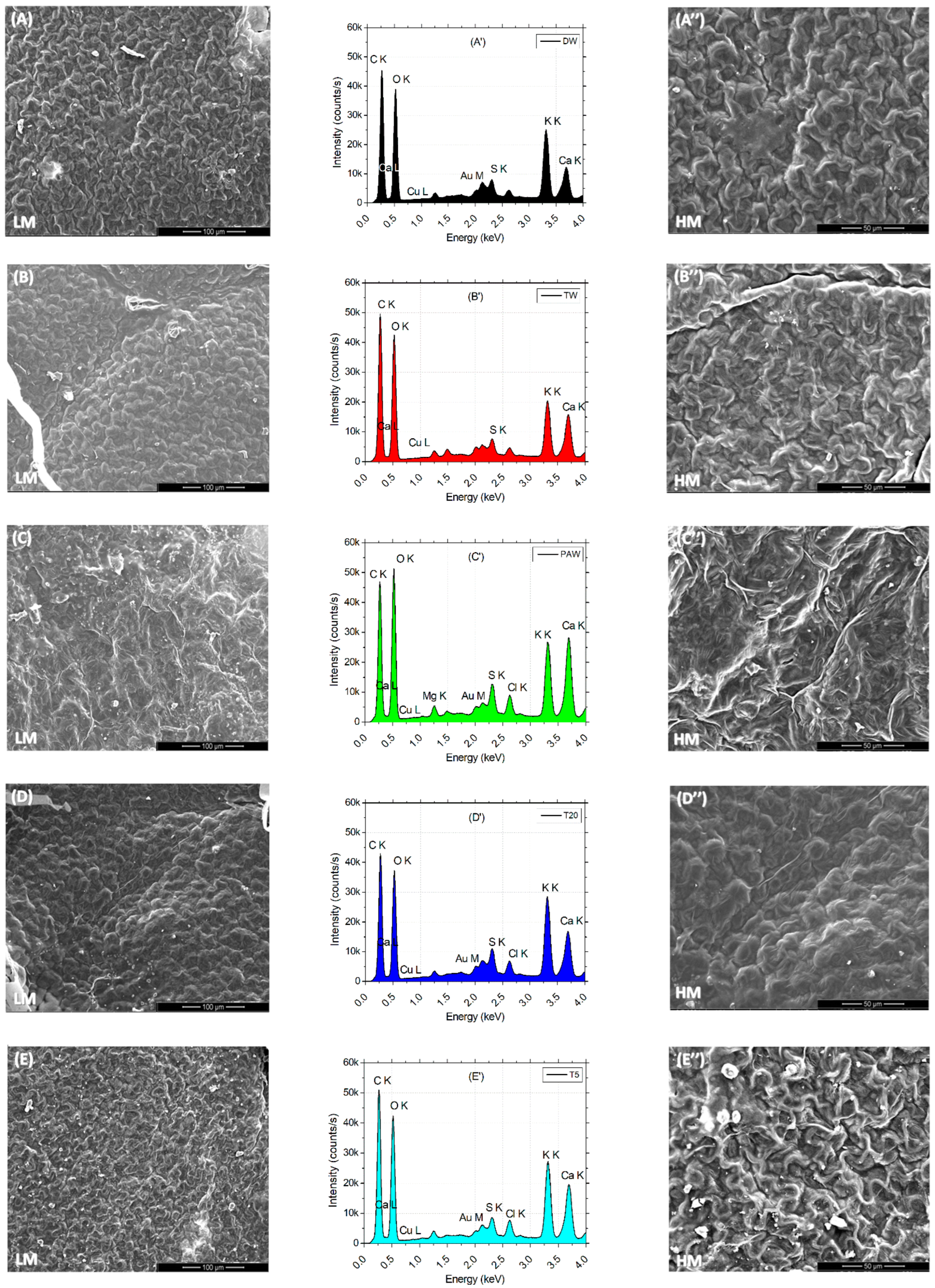
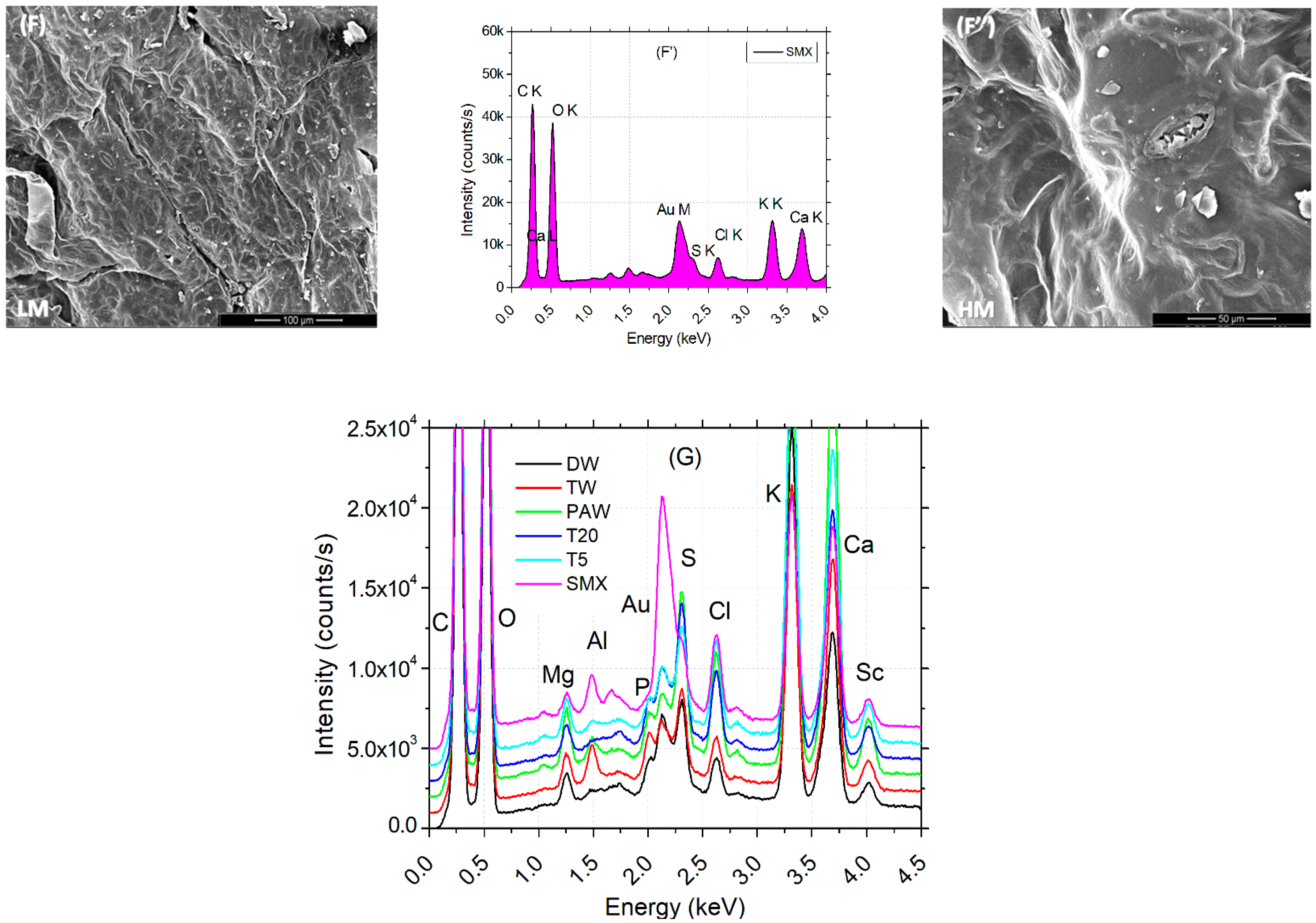
| Variable | DW | TW | PAW | T20 | T5 | SMX |
|---|---|---|---|---|---|---|
| pH units, 21 °C | 6.570 | 7.664 | 8.362 | 7.406 | 7.463 | 7.366 |
| EC μS cm−1, 21 °C | 2.5 | 330 | 334 | 335 | 326 | 324 |
| Solanum lycopersicum L. cv Zaraza | |||||||
|---|---|---|---|---|---|---|---|
| Day 10 | Unit | DW | TW | PAW | T20 | T5 | SMX |
| Root biomass | mg per plant d.w. | 0.62 | 0.62 | 0.65 | 0.65 | 0.48 | 0.46 |
| Shoot biomass | 1.15 | 0.67 | 1.54 | 0.45 | 1.45 | 1.7 | |
| Total weight | 1.77 | 1.29 | 2.19 | 1.1 | 1.93 | 2.16 | |
| Physical–chemical variables before plant sowing | |||||||||
| pH | EC | H | LOI | N-NH4+ | N-NO3− | N-NO2− | DIN | P-PO43− | |
| Scale | Units | [µs cm−1] | [%] | [µg g−1] dry soil | |||||
| Mean | 5.27 | 53.6 | 4.94 | 6.2 | 17.3 | 9.3 | 0.022 | 26.7 | 9.8 |
| SD | 0.03 | 5.238 | 0.15 | 1.03 | 1.6 | 2.1 | 0.003 | 2.7 | 0.07 |
| Geochemical variables (mg kg−1) before seeding the plants | |||||||||
| Element | Ca | Cu | Fe | K | Mn | Zn | As | Ni | Pb |
| Mean initial | 2516 a | 39.5 a | 21,600 a | 10,488 a | 791.5 a | 71.2 a | 9.2 ab | 61.7 a | 17.3 a |
| SD | 527.4 | 8 | 529.1 | 1476 | 58.94 | 2.9 | 2.4 | 17.3 | 2.3 |
| Treatments | Geochemical variables (mg kg−1) after plant harvesting | ||||||||
| DW | 2114 ab | 32.1 ab | 19,546 b | 10,164 a | 665.4 c | 61.3 b | 8 ab | 43.7 a | 15.5 ab |
| TW | 1717 b | 28.8 b | 19,551 b | 9258 a | 671 bc | 63.3 cb | 8.2 ab | 46.9 a | 12.9 bc |
| PAW | 2379 a | 29.8 ab | 20,173 c | 8443 a | 719.5 ab | 68.1 ac | 8.7 a | 53.7 a | 15.7 ab |
| T20 | 2257 ab | 31.4 ab | 20,124 c | 9743 a | 705.1 bc | 63.3 bc | 7.8 ab | 57.4 a | 13.3 bc |
| T5 | 2571 a | 33.2 ab | 19,620 bc | 8604 a | 700.2 bc | 64 bc | 7.4 b | 54.9 a | 14.7 abc |
| SMX | 2449 a | 28.8 ab | 19,715 bc | 9534 a | 687.7 bc | 61.5 b | 8.4 ab | 58.4 a | 12 c |
Disclaimer/Publisher’s Note: The statements, opinions and data contained in all publications are solely those of the individual author(s) and contributor(s) and not of MDPI and/or the editor(s). MDPI and/or the editor(s) disclaim responsibility for any injury to people or property resulting from any ideas, methods, instructions or products referred to in the content. |
© 2025 by the authors. Licensee MDPI, Basel, Switzerland. This article is an open access article distributed under the terms and conditions of the Creative Commons Attribution (CC BY) license (https://creativecommons.org/licenses/by/4.0/).
Share and Cite
Cicirma, M.; Dumitru, M.; Georgescu, S.E.; Neagoe, A. Phytotoxicity Assessment of Solanum lycopersicum L. Seedlings Moderately Irrigated with Non-Thermal Plasma Treated Water Containing Sulfamethoxazole. Plants 2025, 14, 1277. https://doi.org/10.3390/plants14091277
Cicirma M, Dumitru M, Georgescu SE, Neagoe A. Phytotoxicity Assessment of Solanum lycopersicum L. Seedlings Moderately Irrigated with Non-Thermal Plasma Treated Water Containing Sulfamethoxazole. Plants. 2025; 14(9):1277. https://doi.org/10.3390/plants14091277
Chicago/Turabian StyleCicirma, Marius, Marius Dumitru, Sergiu Emil Georgescu, and Aurora Neagoe. 2025. "Phytotoxicity Assessment of Solanum lycopersicum L. Seedlings Moderately Irrigated with Non-Thermal Plasma Treated Water Containing Sulfamethoxazole" Plants 14, no. 9: 1277. https://doi.org/10.3390/plants14091277
APA StyleCicirma, M., Dumitru, M., Georgescu, S. E., & Neagoe, A. (2025). Phytotoxicity Assessment of Solanum lycopersicum L. Seedlings Moderately Irrigated with Non-Thermal Plasma Treated Water Containing Sulfamethoxazole. Plants, 14(9), 1277. https://doi.org/10.3390/plants14091277










